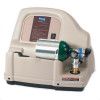Invacare IOH200 Owners Manual - Page 17
Connecting the Cylinder to the Compressor
 |
View all Invacare IOH200 manuals
Add to My Manuals
Save this manual to your list of manuals |
Page 17 highlights
The Hydrostatic Testing Date Aluminum cylinders MUST undergo testing every five years. WARNING! - DO NOT fill cylinders that have not been tested in the past five years. Otherwise, serious personal injury may result. Contact your provider for replacement. External Examination 1. Examine the outside of the cylinder for the following conditions, and replace the cylinder if they exist: • Dents or dings • Arc burns • Oil or grease • Any other signs of damage that might cause a cylinder to be unacceptable or unsafe for use. 2. Examine the cylinder for evidence of fire or thermal damage. Evidence includes charring or blistering of the paint, or other protective coating or heat sensitive indicator. If fire or thermal damage is found, replace the cylinder. 3. Inspect the cylinder/regulator assembly for the following and replace if found: • Debris, oil or grease • Noticeable signs of damage • Signs of corrosion inside the valve • Signs of excessive heat or fire damage Usage 4.3 Connecting the Cylinder to the Compressor WARNING! - NEVER use tools of any kind to connect/disconnect the cylinder and the compressor. Otherwise, severe injury and/or damage may occur. WARNING! - DO NOT drop oxygen cylinders. Use two hands when handling/transporting oxygen cylinders. Otherwise, injury or damage may occur. - DO NOT use a liquid leak detector to test for leaks. 1100873-N 17















